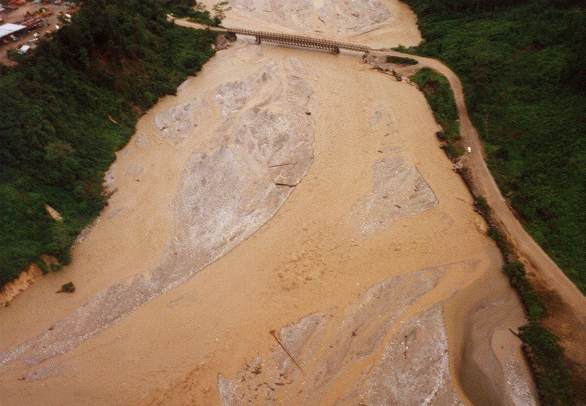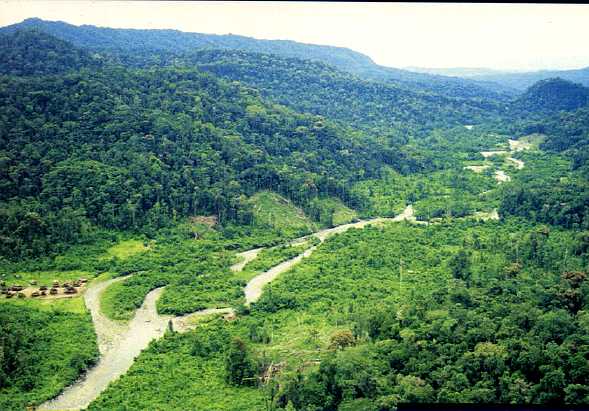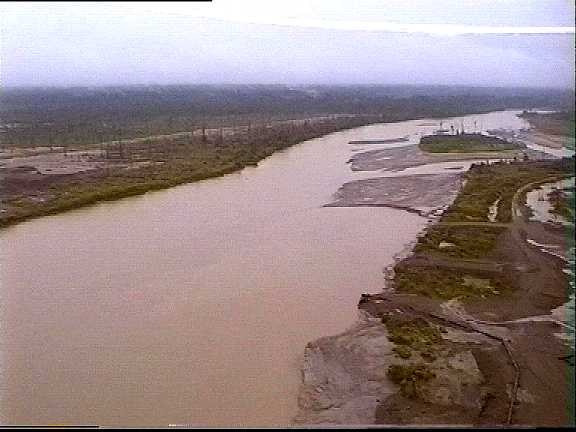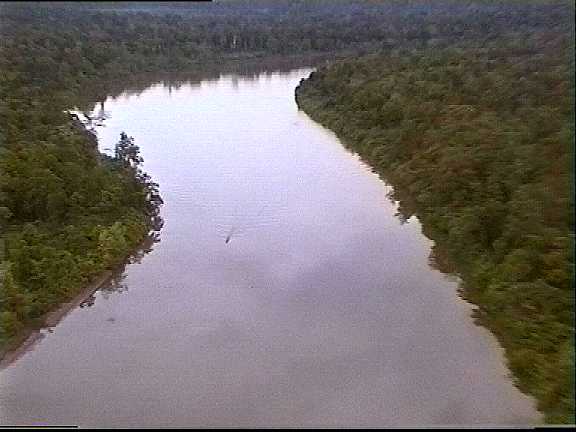Ok Tedi Environment - Impacts
In Chile, where the largest copper mines of the world are operated,
waste is just set aside, and will remain in a desert climate for a long
time. On New Guinea, the situation is more difficult. Tropical rainfall
may wash away any disposals, if not confined by a dam or in a deposit,
that is built and maintained as a building. The government of PNG imposed
to build a tailings reservoir, and OTML started the construction of a dam
south of the mine. However, a landslide damaged the foundation of the dam
in 1984. Considering the impact of a sudden burst of the dam, caused by
landslide or earthquake, the plan of a tailings dam was dropped without
any alternative. PNG government, overriding the advice of its technical
staff (see "Smoking Gun Files"), set levels of pollution, that allowed
OTML to discharge tailings without any treatment.
On the upper Ok Tedi, coarse rock and sand aggraded the river bed.
Ok Mani and Sulphide Creek, just below the dead rock dumpsite, are elevated
50 - 80 m. The Ok Tedi at Tabubil has a river bed elevated 10 - 20 m. Miners
never miss an occasion, to mention the landslides in the mountain areas,
that may fill a river bed in an instant. However, the singular landslides
must not be compared to the steady dumping of mine waste. River bed and
floodplain are never given a break by the mine to recover. The landslide
soil and rock is different in composition from mine waste. No comparable
impacts of landslides at other rivers are observed, like an aggradation
of the Upper Ok Tedi in the course of 90 km, and a massive forest die back
in the floodplain for another 100 km of the Lower Ok Tedi.
A helicopter flight down
Ok Tedi

Massive aggradation of the Ok Tedi river bed at Tabubil

Ok Tedi should look like the Kvirok river, that flows from Mt.
Fubilan to the west. Foto OTML.
When the Ok Tedi enters the lowlands, it descends more smoothly and
slower through its wide floodplain. Here the smaller grains of mine waste
precipitate in such quantities, that the river bed is filled to the rim.
The water floods the plain completely anytime the discharge is a bit higher
than normal. Sand walls trap the water in ponds and oxbows, that it cannot
retreat after a flood. Though vegetation is used to temporary inundation,
it cannot stand that much. The rainforest has died in the plain on an area
exceeding 500 km2 today. The Peer Review Group expressed concern, that
ongoing impact may increase the dieback area to more than 2000 km2. Natural
sediments were welcome to the gardeners along the river as a fertilizer.
Because of the physical impact and unsuitable composition of mine waste,
gardening along the dieback area has become impossible.

Ok Tedi and dieback area at
Bige

The Fly River near Kiunga, upstream its junction with Ok Tedi. The river
and rainforest are visibly intact. See
it in the movie.
Our travel did not lead us further downstream, so the following information
is drawn from literature.The fine fraction of waste, mainly the tailings,
is transported down the whole Fly River to the Gulf of Papua. This problem
is regarded as most serious, because it cannot be limited to a short part
of the river, and not to the main stream. Lagoons, side branches, swamps,
and tributaries in the flatland of the Middle and Lower Fly are spilled
with thin layers of mining silt. This waste is fundamentally different
from natural suspended matter. Its grains fresh out of the mill have sharp
edges, because they were not weatherized and polished, so they may hurt
the gills of fish. Tailings are purely anorganic, without compounds from
soil and organic detritus.
Copper is not completely extracted by flotation, so 120 tons/day of
copper flow down Ok Tedi. Chemically, copper is tightly bound as insoluble
sulphide on lime particles. If sulphides are exposed to air, they are converted
to copperoxides, and sulfuric acid is set free. OTML says, one should not
worry about that, because copperoxide is still insoluble in water, and
lime, the prevalent rock from the pit, will neutralize the acid. This sounds
plausible, if the tailings were disposed, e.g. on the Bige dredge site.
In the river system, however, many biological processes take place, that
may lead to mobilisation of copper and make it available to organisms.
Some are very sensitive to copper, e.g. snails and prawns. Even undissolved
copperoxide has a massive effect on mollusks: sea vessels are painted with
copperoxide as a substitute for organic tin compounds, to prevent fouling.
The effects of an annual load of 30,000 tons of a toxic metal cannot be
covered by the present knowledge, and be predicted as not dangerous.
Hettler concludes from his investigations of sediments in the Middle
Fly River area (1992 - 1995, PhD Thesis, sponsored by UNEP):
Of all trace metals, ...copper is of highest ecological relevance,
because of its strong enrichment..., its high hydrochemical mobility, and
its ecotoxicity even at trace concentration.
The areas of the innundation plain (of the Middle Fly)... play a central
role for reproduction and feeding of fish. This part of the river ecosystem
is most sensitive for changes of the ecological situation, caused by the
mining project.
... it may last for centuries, till the copper enriched layer will
be covered by an uncontaminated layer of sediment.
Original issue April 2001
last update
 Ok Tedi Environment - Rehabilitation?
Ok Tedi Environment - Rehabilitation?
 Index of Ok Tedi pages
Index of Ok Tedi pages
 back to Homepage
back to Homepage
|





